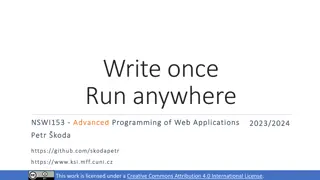Web Application Development Best Practices and Technologies
Explore advanced programming techniques and tools for full-stack web development. Learn about client-side and server-side technologies, event handling, background jobs, resource-intensive tasks, and more in web application development.
Download Presentation

Please find below an Image/Link to download the presentation.
The content on the website is provided AS IS for your information and personal use only. It may not be sold, licensed, or shared on other websites without obtaining consent from the author. Download presentation by click this link. If you encounter any issues during the download, it is possible that the publisher has removed the file from their server.
E N D
Presentation Transcript
Server NSWI153 NSWI153 - - Advanced Advanced Programming of Web Applications Programming of Web Applications 202 2023/2024 3/2024 Petr Petr koda koda https://github.com/skodapetr https://github.com/skodapetr https://www.ksi.mff.cuni.cz https://www.ksi.mff.cuni.cz This work is licensed under a Creative Commons Attribution 4.0 International License.
Starting point <<component>> client <<component>> server <<component>> database GET /api/v1/users SELECT id FROM users GET /api/v1/users/001 SELECT * FROM users WHERE 2
Web application: full-stack developer Visual Framework Angular Material Reactstrap Bootstrap Vuetify UI Framework Angular.js React Vue.js Vanilla JS Redux Server Language PHP Python NodeJS Java HTTP Binding Flask Express.js Jetty Tomcat Spring ??? RabbitMQ Celery CouchDB Nginx <<actor>> browser <<component>> web server <<component>> database 3
Client side @Route("/home") public class HomeView extends VerticalLayout { public HomeView() { TextField textField = new TextField(); Button addButton = new Button("Add"); addButton.addClickListener(event -> { Notification.show(textField.getValue()); }); TextField textField = new TextField(); add(textField, addButton); } } 4
Demo Vaadin 'Create your UI in Java' Flow Hilla Events Components Pricing 5
Event handling What can go wrong ? var connection = database.connect(); public interface Bank { Button addButton = new Button("Add"); void transfer( String from, String to, int amount); addButton.addClickListener(event -> { connection.addItem(textField.getValue()); }); } connection.close(); 6
Resource intensive / long running task Web workers Vertical scaling <<component>> client Horizontal scaling <<component>> server <<component>> server <<component>> server Stateless vs Stateful <<component>> server 8
Background jobs / message queues <<component>> broker <<component>> consumer <<component>> worker Task Queue <<component>> producer Task Queue <<component>> worker Task Queue <<component>> result backend 9
Example: Celery Python Asynchronous distributed task queue Advanced Message Queuing Protocol (AMQP) Components: Producer, Consumer, Message Broker, Result Backend from celery import Celery app = Celery('tasks', broker='... ) from tasks import add add.delay(4, 4) @app.task def add(x, y): return x + y Configuration . 10
Demo Flower
Motivation <<component>> service <<component>> service <<component>> service <<component>> service <<component>> service <<component>> service <<component>> service <<component>> service <<component>> service <<component>> service HTTP/1.1 500 Internal Server Error 14
Monitoring What to monitor? How to monitor? Source Logs Collector Logging Processor / Presenter Log Aggregation Metrics Service Monitoring Infrastructure Monitoring 15
Example Prometheus Grafana Time series Dashboards Multidimensional data Monitor, analyze, alert Pull/Push via HTTP Metrics, logs, traces Alerts <<component>> node_exporter <<component>> Grafana <<component>> Prometheus 16
Architecture System design primer Multiple Components Client, Web-Server, Broker, Worker Quality Attributes Modifiability, Testability, Integrability, Performance, Availability, Introduction to Software Engineering - NSWI041 18
Starting point <<actor>> browser <<component>> web server <<component>> database 19
Background Jobs Message queues Receive hold and deliver messages (A)synchronous execution Task queues Back pressure <<component>> message queue <<component>> message consumer <<component>> client <<component>> database <<component>> server Example of our solution with Celery. 20
Application state Stateful Context of previous transaction. Stateless No stored information. Every operation is made as if from scratch for the first time. <<component>> client <<component>> database <<component>> server Application state in the database, servers are stateless. 21
Proxy SSL termination, compression, caching, Static content Multiple locations <<component>> client <<component>> database <<component>> proxy <<component>> server 22
Reverse proxy Centralize internal services and provide unified interface Hide information about servers (implementation detail) <<component>> server <<component>> reverse proxy <<component>> client <<component>> database <<component>> server The reverse proxy provide a unified API, e.g., /api/v1/users and /api/v1/articles. 23
Cache Improve loading time, reduce server load Client-side caching Multiple locations (Client, CDN, Web server, Database, Application, ) Cache invalidation <<component>> cache-aside <<component>> client <<component>> database <<component>> cache <<component>> server 24
Content delivery network (CDN) Distributed network of proxy servers, minimize distance to user ~ location based Mostly static content like CSS, HTML, JS, <link href="https://cdn.jsdelivr.net/npm/bootstrap@5.1.3/dist/css/bootstrap.min.css" rel="stylesheet crossorigin="anonymous"> Edge computing <<component>> CDN <<component>> client <<component>> database <<component>> server Static content is served from a CDN. Our servers only deal with dynamic content. 25
Load balancer Distribute requests to computing resources Pick a server -> forwards to server -> forwards response to a client SW or HW implementation Horizontal scaling Sticky session <<component>> load balancer <<component>> client <<component>> database <<component>> server Load balancer distribute requests to multiple servers. 26
Database Modern Database Concepts - NDBI040 Principles of Distributed Systems - NSWI035 Database Applications - NDBI026 <<component>> database <<component>> database 27
Example: PrankWeb <<component>> monitoring (NodeJs) <<component>> monitoring (Flower) <<component>> administration <<component>> frontend (React) <<component>> message queue (RabbitMQ) <<component>> message consumer (Python, Java, ) <<component>> client (browser) <<component>> reverse proxy (Nginx) <<component>> web server (Python) <<component>> database (File System) 28
Architecture Data-driven Microservices Event-driven Service Oriented (SOA) 29
Takeaway There is a JavaScript alternative (more later) Background jobs Stateless services Software architecture Cache Proxy Reverse-Proxy Load Balancer 30























